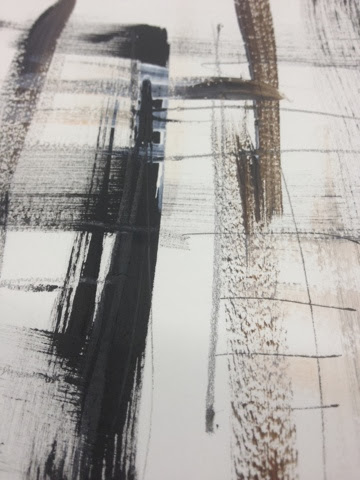For this sampling unit I was given the brief “data roaming”.
I played around with the idea of data and finally decided on the theme of “traces”,
and how data is compiled through traces left behind from people, objects and
processes. I glanced around me and realise the many traces left behind such as
stains from the bottom of a cup, scratches on the table top ect. I took some
photographs and began to create some inspirational drawings concentrating on
shape, line, colour and texture.
I entered the textile world of construct, firstly weave and
created a collection of weave samples; I took the colour pallet of neutral
creams and beiges from my photographs and artist Anne Goddard.
. “Chester based
Ann Goddard combines textile elements with non-traditional textile media such
as wood, slate and concrete. She describes her work as a mixture of crafting
and conceptualising – working on the margins of textile practice & existing
in a border zone between fine art and craft. Themes explore the concept of
boundaries and human impact on the landscape.” (www.textileartist.org ) Her theme links well
to mine as she looks at the impact that humans leave on the landscape and so
the traces that are left behind. Although Anne isn’t a weaver I found her work
very inspirational for my own samples for many reasons including her colour palate
which is clearly shown through my sample with the muted creams alongside a
darker brown tone as with her piece. The way in which her work is very textural
is also something I took forward and introduced into my knit and weave both
through using different yarns and fibre as well as experimenting with a variety
of techniques. Her use of natural media such as wood alongside manmade materials
including concrete was and interesting concept and is shown through my use of
combining natural fibres and yarns such as wool and cotton alongside manmade
yarns; viscose.


The next thinking step for me was where I envisioned my knit and weaves and the context in which they would be, I started by first ruling out fashion and commercial product and realised that they are much more abstract and textural and so more gallery- based work and so I researched this and came along some artists including Jonathan Brilliant’s “To weave. To stack. To stain.” This photograph became very influential in my woven samples I looked at the forms he created the “loop” and brought this into my weaves through the technique of floats. Clear influences are shown through the colour scheme and textural effect.
Another extremely influential artist in my work is Sonya
Phillips, she’s a knitter who creates both large and small scale abstract pieces
showcased within installations in galleries this is one reason I found her work
interesting. I used partial knit to create the small sections of colour change
similar to that of Sonya’s, I used a varied thickness of yarns and hooking up
to give a tactile surface. This artist influenced may of my final knit samples.
To take my samples further I would experiment with scale and composition to create large textural gallery-based installations as this is where I see me work for an audience interested in traditional crafts used in an abstract form. All of my sample link back to my theme of traces as surely a knit or weave sample is a trace left from yarn, needle or a loom.
Sam. (). Featured artist Ann Goddard – Crafting &
conceptualising. Available:
http://www.textileartist.org/crafting-and-conceptualising-2/. Last accessed
18th feb 2014.
























